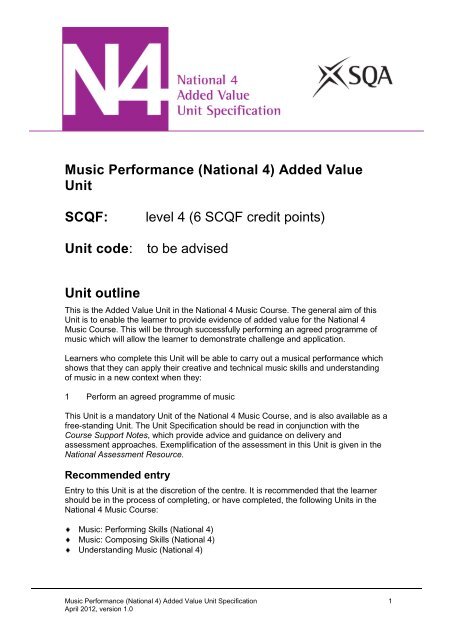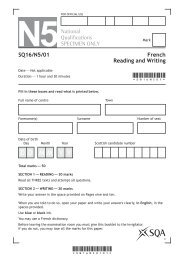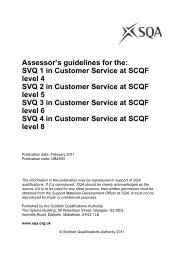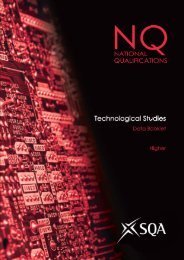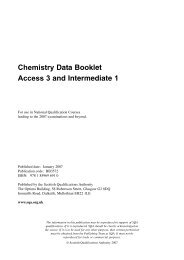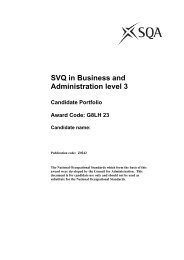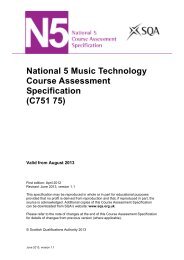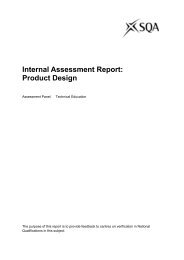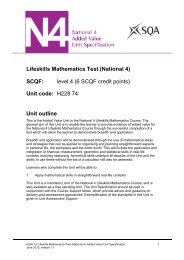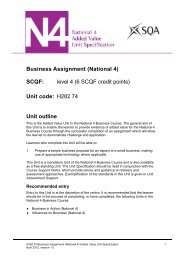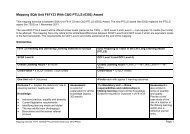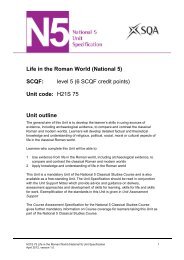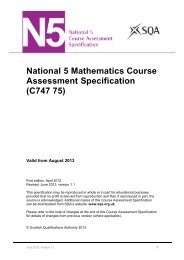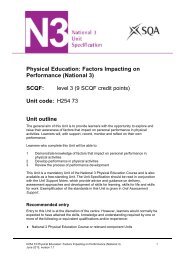Music Performance (National 4) - Scottish Qualifications Authority
Music Performance (National 4) - Scottish Qualifications Authority
Music Performance (National 4) - Scottish Qualifications Authority
You also want an ePaper? Increase the reach of your titles
YUMPU automatically turns print PDFs into web optimized ePapers that Google loves.
<strong>Music</strong> <strong>Performance</strong> (<strong>National</strong> 4) Added Value<br />
Unit<br />
SCQF: level 4 (6 SCQF credit points)<br />
Unit code: to be advised<br />
Unit outline<br />
This is the Added Value Unit in the <strong>National</strong> 4 <strong>Music</strong> Course. The general aim of this<br />
Unit is to enable the learner to provide evidence of added value for the <strong>National</strong> 4<br />
<strong>Music</strong> Course. This will be through successfully performing an agreed programme of<br />
music which will allow the learner to demonstrate challenge and application.<br />
Learners who complete this Unit will be able to carry out a musical performance which<br />
shows that they can apply their creative and technical music skills and understanding<br />
of music in a new context when they:<br />
1 Perform an agreed programme of music<br />
This Unit is a mandatory Unit of the <strong>National</strong> 4 <strong>Music</strong> Course, and is also available as a<br />
free-standing Unit. The Unit Specification should be read in conjunction with the<br />
Course Support Notes, which provide advice and guidance on delivery and<br />
assessment approaches. Exemplification of the assessment in this Unit is given in the<br />
<strong>National</strong> Assessment Resource.<br />
Recommended entry<br />
Entry to this Unit is at the discretion of the centre. It is recommended that the learner<br />
should be in the process of completing, or have completed, the following Units in the<br />
<strong>National</strong> 4 <strong>Music</strong> Course:<br />
<strong>Music</strong>: Performing Skills (<strong>National</strong> 4)<br />
<strong>Music</strong>: Composing Skills (<strong>National</strong> 4)<br />
Understanding <strong>Music</strong> (<strong>National</strong> 4)<br />
<strong>Music</strong> <strong>Performance</strong> (<strong>National</strong> 4) Added Value Unit Specification 1<br />
April 2012, version 1.0
Equality and inclusion<br />
This Unit Specification has been designed to ensure that there are no unnecessary<br />
barriers to learning or assessment. The individual needs of learners should be taken<br />
into account when planning learning experiences, selecting assessment methods or<br />
considering alternative evidence. For further information, please refer to the Course<br />
Support Notes.<br />
<strong>Music</strong> <strong>Performance</strong> (<strong>National</strong> 4) Added Value Unit Specification 2<br />
April 2012, version 1.0
Standards<br />
Outcomes and assessment standards<br />
Outcome 1<br />
The learner will carry out a musical performance which shows that they can apply their<br />
creative and technical music skills and understanding of music in a new context when:<br />
1 Performing an agreed programme of music by:<br />
1.1 Selecting, with some support, two or more pieces of music for two contrasting<br />
instruments, or one instrument and voice<br />
1.2 Performing the agreed music on their selected instruments, or one instrument<br />
and voice, with sufficient technical accuracy in pitch and rhythm<br />
1.3 Maintaining musical flow throughout the programme of music in solo and/or group<br />
performances<br />
1.4 Realising the composers’ intentions with regard to phrasing and dynamics<br />
1.5 Reflecting on the strengths and weaknesses of their performance<br />
Evidence Requirements for the Unit<br />
This Unit will be assessed through controlled assessment which meets the Evidence<br />
Requirements below.<br />
The assessment method for this Unit will be a performance of a programme of music<br />
on either two selected instruments, or on a selected instrument and voice. The<br />
programme can be solo and/or in a group setting.<br />
The programme of music should last a total of eight minutes.<br />
The performance time on either of the two selected instruments, or instrument and<br />
voice, must be a minimum of two minutes within the overall eight-minute programme.<br />
Learners should perform a minimum of two contrasting pieces of music on each of the<br />
two selected instruments, or instrument and voice.<br />
The performance will assess learners’ skills in selecting music for the programme,<br />
performing and evaluating their performance.<br />
The performance is:<br />
set by centres within the SQA guidelines described below<br />
conducted under some supervision and control<br />
Evidence will be internally marked by centre staff in line with SQA guidelines.<br />
All assessment is subject to quality assurance by SQA.<br />
<strong>Music</strong> <strong>Performance</strong> (<strong>National</strong> 4) Added Value Unit Specification 3<br />
April 2012, version 1.0
Setting the assessment<br />
The performance will be set by centres within the following guidelines:<br />
All learners should be provided with a clear outline of the assessment, including<br />
when and how they will be assessed. The agreed music programme should allow<br />
the learner to demonstrate a range of musical skills.<br />
The scope and nature of the music programme will be agreed between the learner<br />
and the teacher/lecturer. The teacher/lecturer should offer the learner guidance on<br />
an appropriate choice of music.<br />
The teacher/lecturer will provide overall guidelines for the performance, including<br />
questions/tasks/prompts which will lead learners through the assessment in clear<br />
stages. This should involve advice which assists the learner to describe and explain<br />
the key features of the performance.<br />
The teacher/lecturer will also determine the nature and amount of support required<br />
and may offer learners guidance to help them to progress through the stages of the<br />
assignment.<br />
Conducting the assessment<br />
The performance will be conducted under some supervision and control. This will take<br />
the form of the following:<br />
The learner should complete the performance in solo and/or group settings.<br />
The performance should be ‘live’ and will be carried out in front of an audience in a<br />
familiar classroom setting. In this case, an audience is defined as one or more<br />
observers, which may include other learners or teacher/lecturers.<br />
The learner will be allowed time for:<br />
selecting suitable development ideas and planning how to develop these with the<br />
teacher/lecturer’s guidance and support<br />
preparing for and carrying out the performance of the programme of music<br />
evaluating their performance<br />
Teachers/lecturers can provide guidance and support to help learners prepare for<br />
and evaluate the performance. This could be, for example:<br />
by helping the learner to select suitable music and to consider how this could be<br />
combined in a programme<br />
by providing guidance to help the learner reflect on and evaluate strengths and<br />
areas for improvement of the performance<br />
Judging the evidence<br />
Evidence will be internally marked and verified by centre staff in line with SQA<br />
guidelines.<br />
All assessment is subject to quality assurance by SQA.<br />
Assessment evidence should include the following:<br />
<strong>Performance</strong> evidence — the learner will perform with sufficient accuracy to realise the<br />
composers’ intentions for the pieces with regard to phrasing and dynamics. They will<br />
effectively use the required musical technique(s) and convey the pitch and rhythm of<br />
notes correctly and at the appropriate tempo, and show their ability to communicate<br />
with the listener while performing.<br />
<strong>Music</strong> <strong>Performance</strong> (<strong>National</strong> 4) Added Value Unit Specification 4<br />
April 2012, version 1.0
An observation checklist should be used to record individual learners’ achievement<br />
during the performance.<br />
An evaluation of their performance, showing their ability to identify two strengths and<br />
two areas for improvement — the evaluation can be presented using any combination<br />
of written/visual/oral/multimedia formats.<br />
The tasks will be assessed by the teacher/lecturer on a pass/fail basis.<br />
Re-assessment<br />
In relation to Unit assessment, SQA’s guidance on re-assessment for Units applies.<br />
Further information is provided in the exemplification of assessment in the <strong>National</strong><br />
Assessment Resource. Advice and guidance on possible approaches to assessment is<br />
provided in the Course Support Notes.<br />
<strong>Music</strong> <strong>Performance</strong> (<strong>National</strong> 4) Added Value Unit Specification 5<br />
April 2012, version 1.0
Development of skills for learning, skills for life<br />
and skills for work<br />
Please refer to the Course Specification for information about skills for learning, skills<br />
for life and skills for work.<br />
Further mandatory information on Course coverage for the <strong>National</strong> 4 <strong>Music</strong><br />
Course<br />
The following gives details of mandatory music concepts and skills, knowledge and<br />
understanding for the <strong>National</strong> 4 <strong>Music</strong> Course. Assessment of this Added Value Unit<br />
will involve selecting appropriate skills, knowledge and understanding from those listed<br />
below, in line with the Evidence Requirements above.<br />
This list of skills, knowledge and understanding also provides the basis for the<br />
assessment of all the Units in the Course:<br />
preparing and performing a solo and/or group programme of music on two selected<br />
instruments, or on one instrument and voice<br />
performing a variety of music extracts with sufficient accuracy while maintaining the<br />
musical flow<br />
reflecting on and evaluating their musical and creative skills and identifying areas<br />
for improvement<br />
understanding the creative process and common approaches used by composers<br />
and musicians to create their music<br />
a basic understanding of the social and cultural influences on music<br />
creating original music using straightforward compositional methods and levelspecific<br />
music concepts in imaginative ways to realise their creative intentions<br />
the ability to identify and recognise familiar annotated music signs and symbols<br />
recognising and distinguishing level-specific music concepts and music styles<br />
<strong>Music</strong> <strong>Performance</strong> (<strong>National</strong> 4) Added Value Unit Specification 6<br />
April 2012, version 1.0
Mandatory music concepts (<strong>National</strong> 4)<br />
At this level, learners’ knowledge and understanding of music will include and build on<br />
the mandatory music concepts for the <strong>National</strong> 3 Course in addition to those shown<br />
below.<br />
Contexts for learning<br />
Knowledge and understanding of music will be developed by performing, listening to<br />
and composing music in this Course.<br />
Styles Melody/<br />
harmony<br />
Baroque Major/minor<br />
Ragtime (tonality)<br />
Romantic Drone<br />
Swing Broken<br />
Concerto chord/arpeggio<br />
Opera Chord<br />
Scots progressionballads<br />
chords I,IV and<br />
Mouth<br />
music<br />
V (major keys)<br />
Reggae Change of key<br />
African Pedal<br />
music Scale<br />
rapping Pentatonic scale<br />
Octave<br />
Vamp<br />
Scat singing<br />
Ornament<br />
<strong>Music</strong> literacy content<br />
Rhythm/<br />
tempo<br />
Syncopation<br />
Scotch snap<br />
Strathspey<br />
Jig<br />
Simple time-<br />
2 3 4<br />
4 4 4<br />
and<br />
compound<br />
time<br />
Anacrusis<br />
Andante<br />
Accelerando<br />
Rallentando<br />
A tempo<br />
Dotted<br />
rhythms<br />
Texture/structure/<br />
form<br />
Canon<br />
Ternary — ABA<br />
Verse and chorus<br />
Middle 8<br />
Theme and<br />
variation<br />
Cadenza<br />
Imitation<br />
Timbre/<br />
dynamics<br />
Brass band,<br />
wind band<br />
Violin, cello,<br />
double bass,<br />
harp<br />
Flute, clarinet,<br />
saxophone,<br />
pan pipes,<br />
recorder<br />
Trumpet,<br />
trombone<br />
Timpani —<br />
snare drum,<br />
bass drum,<br />
cymbals,<br />
triangle,<br />
tambourine,<br />
guiro,<br />
xylophone,<br />
glockenspiel<br />
Harpsichord<br />
bass guitar<br />
Distortion<br />
Muted<br />
Soprano, alto,<br />
tenor, bass<br />
backing vocals<br />
<strong>Music</strong> <strong>Performance</strong> (<strong>National</strong> 4) Added Value Unit Specification 7<br />
April 2012, version 1.0
Treble clef stave<br />
C-A’<br />
sequences<br />
Semi quaver<br />
Grouped semi<br />
quavers<br />
paired<br />
quavers<br />
Repeat signs<br />
mf – mezzo<br />
forte<br />
mp –mezzo<br />
piano<br />
<strong>Music</strong> <strong>Performance</strong> (<strong>National</strong> 4) Added Value Unit Specification 8<br />
April 2012, version 1.0
Administrative information<br />
Published: April 2012 (version 1.0)<br />
Superclass: to be advised<br />
History of changes to <strong>National</strong> Unit Specification<br />
Version Description of change Authorised by Date<br />
© <strong>Scottish</strong> <strong>Qualifications</strong> <strong>Authority</strong> 2012<br />
This specification may be reproduced in whole or in part for educational purposes<br />
provided that no profit is derived from reproduction and that, if reproduced in part, the<br />
source is acknowledged. Additional copies of this Unit can be downloaded from SQA’s<br />
website at www.sqa.org.uk.<br />
Note: readers are advised to check SQA’s website: www.sqa.org.uk to ensure they are<br />
using the most up-to-date version of the Unit Specification.<br />
<strong>Music</strong> <strong>Performance</strong> (<strong>National</strong> 4) Added Value Unit Specification 9<br />
April 2012, version 1.0


